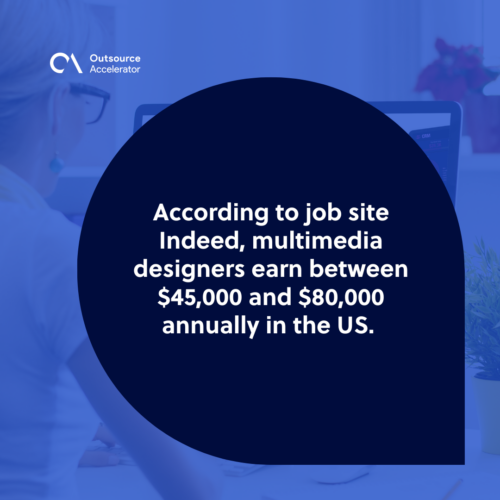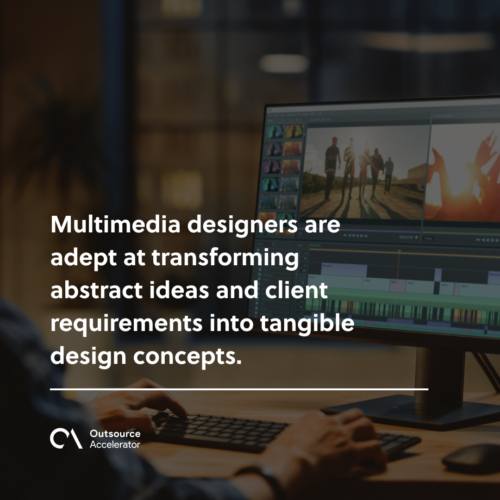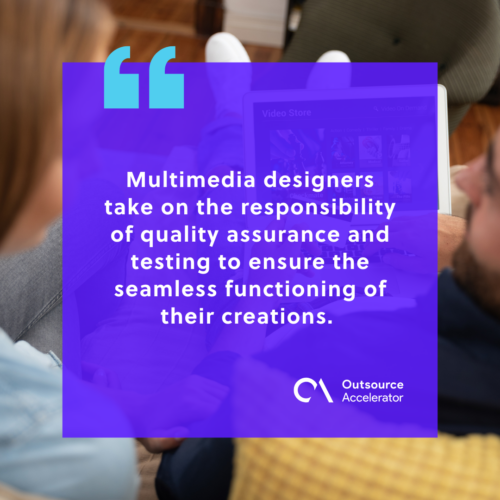10 essential responsibilities of a multimedia designer

Multimedia design is a rapidly evolving field that combines creativity, technology, and communication to deliver engaging and interactive digital experiences.
It plays a crucial role in creating visual content that captivates audiences across various industries. One reason is that multimedia design has emerged as a powerful medium for communication and storytelling.
Statistics underscore the significance of multimedia design in capturing and retaining audience attention. HubSpot’s latest State of Marketing report reveals that 70% of companies invest in content marketing strategies, which include visual marketing.
Multimedia designers are the ones to talk to in terms of making presentable visual content.
This article will explore the key responsibilities of a multimedia designer.
What does a multimedia designer do?
Multimedia designers are highly skilled professionals who combine their creative and technical expertise to produce digital content. They are responsible for designing and creating visually appealing and interactive digital materials such as websites, animations, and user interfaces.
These professionals deeply understand design principles, digital technologies, and user experience (UX) concepts.
Multimedia designer salary
The salary of a multimedia designer can vary depending on factors such as experience, location, industry, and company size.
According to job site Indeed, multimedia designers earn between $45,000 and $80,000 annually in the US. Depending on the circumstances, the actual amount varies based on the specific job market and individual qualifications.
Freelancers and fresh graduates, for instance, may be paid lower since they are starting their careers. Meanwhile, senior designers with extensive experience and specialized skills can demand higher salaries.

Industries where multimedia designers work
Multimedia designers are in demand across various industries that require engaging visual content to convey their messages effectively.
Some common sectors where multimedia designers find employment include:
- Marketing. Multimedia designers contribute to creating compelling advertisements, promotional materials, and marketing campaigns that capture attention and drive customer engagement.
- Entertainment and media. Multimedia designers are also the heart of the entertainment industry. They play a vital role in producing captivating graphics, animations, and visual effects for shows, video games, and digital media platforms.
- Development. These designers collaborate with web and mobile development teams to create visually appealing user interfaces, interactive features, and engaging multimedia content.
- Education. Multimedia designers contribute to developing interactive educational materials, e-learning courses, and instructional videos that enhance a student’s learning experience.
- Architecture. They assist architects and interior designers in visualizing their projects by creating realistic 3D renderings, animations, and virtual walkthroughs.
- Product design. Multimedia designers contribute to creating product prototypes, packaging designs, and marketing materials that showcase the features and benefits of various products.
- Fashion and apparel. Multimedia designers play a crucial role in the fashion industry by designing visually stunning graphics, branding elements, and multimedia content for clothing brands, fashion shows, and online platforms.
- Corporate communications. Supporting corporate communication teams is also part of multimedia designers’ role. They create engaging visual content for internal and external communications, including presentations, videos, and infographics.
- Healthcare. Multimedia designers contribute to creating visual content for medical training, patient education, healthcare campaigns, and medical device user interfaces.
- Nonprofit and social causes. A multimedia designer helps nonprofit organizations and social causes by creating impactful visual content that raises awareness, educates the public, and drives action for positive change.
10 responsibilities of a multimedia designer
A multimedia designer possesses multiple responsibilities, such as the following:
1. Conceptualizing and ideating
At the core of a multimedia designer’s responsibilities is the ability to conceptualize and ideate. They are adept at transforming abstract ideas and client requirements into tangible design concepts.
Multimedia designers brainstorm and develop creative ideas and concepts for various projects. They collaborate with clients, stakeholders, and team members to understand project objectives and translate them into visual designs.

2. Visual design and layout
A key responsibility of a multimedia designer is to create visually appealing designs and layouts according to the project’s goals and target audience.
Multimedia designers possess a strong foundation in design principles. They skillfully use color theory, typography, and composition to create visually appealing designs.
Some of their expected outputs include logos, illustrations, infographics, and typography. They also create other visual assets that effectively communicate the client’s message and align with their brand identity.
3. Digital content creation
Multimedia designers are also experts in digital content creation. They are proficient in using industry-standard software tools to produce high-quality content suitable for every platform.
Multimedia designers use their skills and creativity to develop digital content such as graphics, animations, videos, and interactive elements. They bring their ideas to life, ensure seamless navigation, and maintain their content’s purpose and messaging.
With expertise in video editing, they can also edit raw footage, add visual effects, fine-tune audio, and synchronize multimedia elements. They ensure the final video product is polished, cohesive, and in line with the client’s specifications.
4. Collaboration and communication
Effective collaboration and communication are essential skills for multimedia designers. They often work in cross-functional teams, collaborating with clients, project managers, developers, and copywriters.
Clear and concise communication ensures all stakeholders align with the project vision, objectives, and timeline.
For instance, multimedia designers collaborate with development teams to build websites and software systems. They update and help teams in coding and combining visual designs to make their outputs visually stunning and user-friendly.
5. User experience (UX) design
Multimedia designers play a crucial role in creating seamless user experiences. They deeply understand UX principles and apply them to their work.
Considering the end user’s perspective is crucial for multimedia designers. They focus on ensuring customers experience smooth navigation and interactions on the systems they help create.
At the same time, they help in conducting user research and creating wireframes and prototypes. They are responsible for optimizing the interface and interaction design to achieve the best results with their work.
6. Multimedia asset management
Managing multimedia assets is another responsibility of multimedia designers. They organize and maintain libraries or databases of visual content, ensuring easy access, version control, and efficient asset reuse.
To effectively handle asset management, multimedia designers employ several strategies, such as the following:
- File organization. Multimedia designers establish a systematic folder structure and file naming to categorize and store different types of assets based on themes, projects, or clients.
- Metadata tagging. A multimedia designer often implements metadata tagging to enhance asset searchability. By adding relevant metadata to assets, designers can easily search and filter files based on specific criteria.
- Use of asset management tools. Additionally, multimedia designers leverage digital asset management (DAM) systems as a centralized repository for storing, organizing, and retrieving multimedia assets.
7. Quality assurance and testing
Multimedia designers take on the responsibility of quality assurance and testing to ensure the seamless functioning of their creations. They conduct thorough checks to identify and resolve any design or functionality issues.
Multimedia designers conduct thorough testing to ensure their works function as intended across different platforms and devices. They identify and resolve design or functionality issues to deliver a seamless user experience.

8. Keeping up with trends
The field of multimedia design is constantly evolving, with new technologies, tools, and trends emerging regularly.
Multimedia designers take the responsibility to stay updated with industry developments. They proactively explore new design trends, experiment with innovative techniques, and acquire new skills and tools.
9. Project management
Managing time effectively and meeting project deadlines is essential for multimedia designers. They often possess strong project management skills and know how to prioritize tasks, setting them according to their design procedures and urgency.
Through project management practices, they ensure the timely completion of deliverables without compromising on quality.
10. Portfolio development
Building an impressive portfolio is a responsibility that multimedia designers undertake to showcase their skills and expertise. They curate a collection of their best work, highlighting their ability to create visually stunning and engaging multimedia content.
A well-presented portfolio demonstrates their versatility, creativity, and technical proficiency, attracting potential clients and career opportunities.
Hiring a multimedia designer
Employers usually look for the following qualifications when hiring a multimedia designer.
- Portfolio. Review the candidate’s portfolio to assess the quality and diversity of their work. Look for projects that align with your industry and design requirements.
- Technical skills. Ensure the candidate possesses a strong foundation in multimedia design software and has expertise in relevant technologies.
- Creativity and problem-solving abilities. Look for candidates who demonstrate creativity, innovative thinking, and the ability to solve design challenges effectively.
- Adaptability and learning aptitude. Multimedia design is a dynamic field. Seek candidates that are adaptable, open to learning, and eager to stay updated with industry trends.
- Cultural fit. Consider how well the candidate’s values, work style, and personality align with your organization’s culture and values.
Multimedia designers are crucial in creating visually appealing and engaging digital content. Their responsibilities span from conceptualizing and designing to collaborating with cross-functional teams and ensuring a seamless user experience.
Employers have various options for hiring a multimedia designer. Most companies, whether starting or established, usually start with an in-house designer to help them with visual projects.
Meanwhile, another way to hire a designer is by delegating the function to a freelancer or an outsourced multimedia team.
Getting offshore staffing in destinations such as India and the Philippines can help companies get equally good – or even better – results at a fraction of the cost of hiring local teams.







 Independent
Independent




